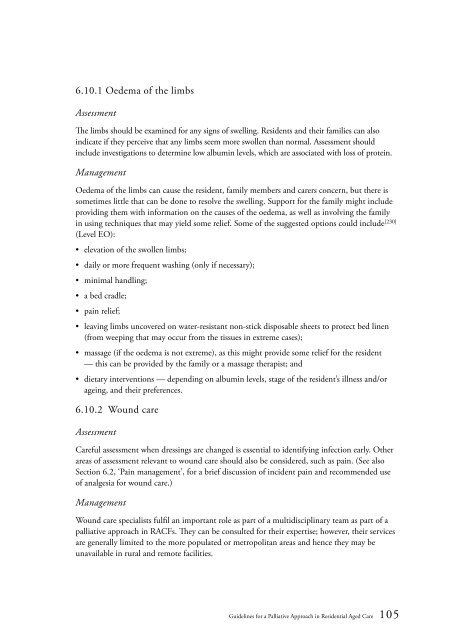Guidelines for a Palliative Approach in Residential Aged Care
Guidelines for a Palliative Approach in Residential Aged Care
Guidelines for a Palliative Approach in Residential Aged Care
You also want an ePaper? Increase the reach of your titles
YUMPU automatically turns print PDFs into web optimized ePapers that Google loves.
6.10.1 Oedema of the limbs<br />
Assessment<br />
The limbs should be exam<strong>in</strong>ed <strong>for</strong> any signs of swell<strong>in</strong>g. Residents and their families can also<br />
<strong>in</strong>dicate if they perceive that any limbs seem more swollen than normal. Assessment should<br />
<strong>in</strong>clude <strong>in</strong>vestigations to determ<strong>in</strong>e low album<strong>in</strong> levels, which are associated with loss of prote<strong>in</strong>.<br />
Management<br />
Oedema of the limbs can cause the resident, family members and carers concern, but there is<br />
sometimes little that can be done to resolve the swell<strong>in</strong>g. Support <strong>for</strong> the family might <strong>in</strong>clude<br />
provid<strong>in</strong>g them with <strong>in</strong><strong>for</strong>mation on the causes of the oedema, as well as <strong>in</strong>volv<strong>in</strong>g the family<br />
<strong>in</strong> us<strong>in</strong>g techniques that may yield some relief. Some of the suggested options could <strong>in</strong>clude [230]<br />
(Level EO):<br />
• elevation of the swollen limbs;<br />
• daily or more frequent wash<strong>in</strong>g (only if necessary);<br />
• m<strong>in</strong>imal handl<strong>in</strong>g;<br />
• a bed cradle;<br />
• pa<strong>in</strong> relief;<br />
• leav<strong>in</strong>g limbs uncovered on water-resistant non-stick disposable sheets to protect bed l<strong>in</strong>en<br />
(from weep<strong>in</strong>g that may occur from the tissues <strong>in</strong> extreme cases);<br />
• massage (if the oedema is not extreme), as this might provide some relief <strong>for</strong> the resident<br />
— this can be provided by the family or a massage therapist; and<br />
• dietary <strong>in</strong>terventions — depend<strong>in</strong>g on album<strong>in</strong> levels, stage of the resident’s illness and/or<br />
age<strong>in</strong>g, and their preferences.<br />
6.10.2 Wound care<br />
Assessment<br />
<strong>Care</strong>ful assessment when dress<strong>in</strong>gs are changed is essential to identify<strong>in</strong>g <strong>in</strong>fection early. Other<br />
areas of assessment relevant to wound care should also be considered, such as pa<strong>in</strong>. (See also<br />
Section 6.2, ‘Pa<strong>in</strong> management’, <strong>for</strong> a brief discussion of <strong>in</strong>cident pa<strong>in</strong> and recommended use<br />
of analgesia <strong>for</strong> wound care.)<br />
Management<br />
Wound care specialists fulfil an important role as part of a multidiscipl<strong>in</strong>ary team as part of a<br />
palliative approach <strong>in</strong> RACFs. They can be consulted <strong>for</strong> their expertise; however, their services<br />
are generally limited to the more populated or metropolitan areas and hence they may be<br />
unavailable <strong>in</strong> rural and remote facilities.<br />
<strong>Guidel<strong>in</strong>es</strong> <strong>for</strong> a <strong>Palliative</strong> <strong>Approach</strong> <strong>in</strong> <strong>Residential</strong> <strong>Aged</strong> <strong>Care</strong> 105
















